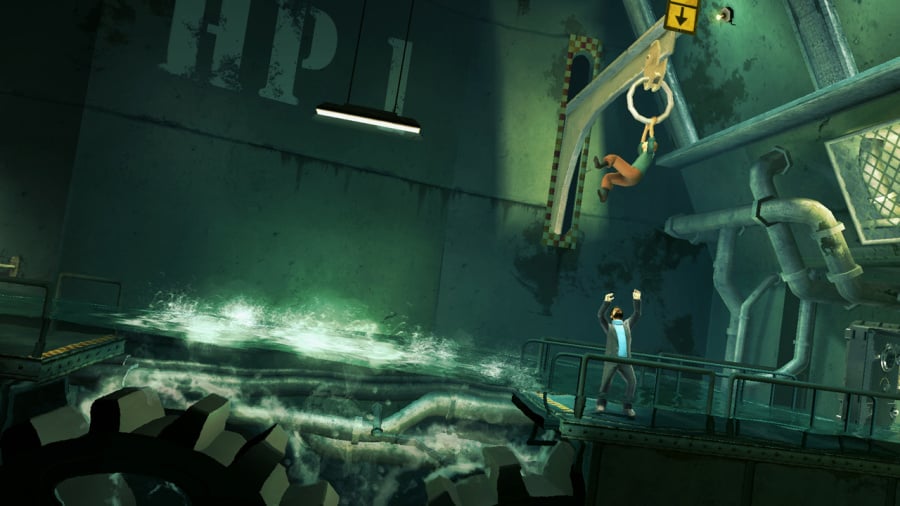
You know the drill by now: The Adventures of Tintin: The Secret of the Unicorn is a film tie-in. It also uses Kinect. It can't be any good, right?
Well, the drill has changed slightly this time around. Unlike THQ's efforts such as Kung Fu Panda 2, Tintin is a standard controller-led platformer, with Kinect's functions tucked away in the form of challenges. Here you can drop the pad and use your body to pilot a plane, take on a pirate in a sword fight and fire a slingshot from a sidecar, although it's also worth saying these challenges are available to pad-only players too.
These minigames are necessarily simplistic: swordfighting is generally a matter of flailing your arm to strike, then holding it in one of three positions to block incoming attacks. It's a waggle-fest essentially, and in a few weeks we'll see Puss in Boots come along with a slightly more elegant and engaging fighting style; Tintin's swashes buckle too easily.

The plane sections fare a little better: in some you must fly through rings to snap photos, Pilotwings Resort-style, and in others you must track down enemy planes by holding them in your sights long enough to lock on, at which point you begin firing by performing an over-enthusiastic series of sumo pushes. It's quite a sight.
Rounding out the trio are a number of motorbike sidecar challenges that let you fire a slingshot or just race around to set a fastest lap. As with the other sensor functions, the controls are responsive and there are multiple levels to work your way through, adding a couple of hours of hands-free content to the overall package. None of the challenges are particularly engaging though, and there's no real reason to drop the controller other than because you can, no matter how entertaining it sounds to sumo slap a plane out of the sky.
The main game itself doesn't use Kinect in any way: that's for the best as it's a pretty standard 2D platformer, with leaps and ladders and switch puzzles to take on. It plays like a Prince of Persia for kids: the timing on your jumps is generous, enemies are easily overcome and in the three or four hours it'll take you to finish the adventure you'll rarely have to engage much of your brainpower. The pace is gentle but consistent, apart from interstitial sections that see you tracking footprints as Snowy or plodding over a world map, your route already set out as a dotted line. While there's some of the comics' abundant charm in these sections, they're too easy to get bogged down in and feel like filler in the gaps between 2D stages.

There are rare visual delights dotted around — a scene splicing two different Haddocks wrecking their respective boats is classy — but this title sits uncomfortably between the artistic design of the comics and the new film, never quite establishing its own style: never unattractive, it never quite hits the heights either. The music, however, is uniformly excellent: adventurous and rousing, it's pure Spielberg and John Williams in Indiana Jones mode.
Aside from the story-driven adventure there's also a two-player co-operative mode which ditches the unnecessary interludes in favour of 21 unique stages set in Captain Haddock's nightmares. It's bizarre and makes no sense in any other universe, but hey, this is a game about a teenager and his dog searching for a mysterious sunken treasure. It works, and even in single player it's enjoyable stuff, with plenty of unlockables to nab: famous characters and costumes have to be earned, and overall this mode acts like a "best bits" of the campaign, only with extra flying alarm clocks and looming Tintins.

It's just a shame that the rest of the game isn't quite so imaginative. Your next action is almost always literally signposted: your first wall-jump section actually has arrows directing you to bounce from one side to the other, and by the time you've cleared half the game you're practically on auto-pilot. There's no penalty for failure either: a short animation shows Tintin being knocked out (but never dead) and you're quickly brought back to an invisible checkpoint. Inexperienced players might find the game more of a challenge, but anyone with a history in Mario or Prince of Persia will sail through.
Conclusion
The Kinect features here are functional and unlikely to make you return, and the adventure mode itself is moderately enjoyable at best. The two-player co-op is the game's best offering, but after spending several hours with Tintin the best thing we can say about it is that it's "not bad".
Comments 0
Wow, no comments yet... why not be the first?
Leave A Comment
Hold on there, you need to login to post a comment...